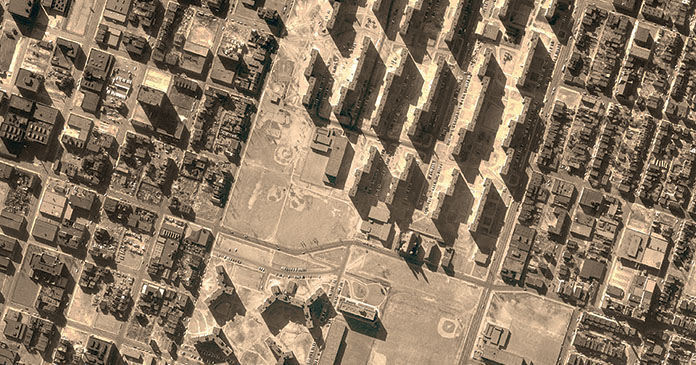On the 50th anniversary of the demolition of Pruitt-Igoe, it’s nearly impossible to understate the failure of the St. Louis public housing project.
Famed architect Minoro Yamasaki, who would go on to design the World Trade Center received praise for his vision of the 57-acre property where Pruitt-Igoe once stood, even though his original plans didn’t exactly come to fruition. The property had significant structural and design problems (including “skip-stop” elevators that encouraged stairwell crime by only stopping on select floors) and it’s widely accepted that the housing project only exacerbated the ills of poverty and substandard housing.
Pruitt-Igoe represented complete racial and economic segregation. The building was dominated by single mother households that symbolized the collateral damage of public assistance. This was described by sociologist Lee Rainwater, in his book Behind Ghetto Walls: Life in a Federally-Subsidized Slum, “Only those Negroes who are desperate for housing are willing to live in Pruitt-Igoe.” When imploded the buildings weren’t even two decades old.
The problems that toppled Pruitt-Igoe do not go nearly far enough to capture the deeply mistaken assumptions about government housing policy whose bad ideas continue today.
After clearing seedy areas, housing reformers who pushed for Pruitt-Igoe assumed that the neighborhoods they replaced were irredeemably bad and required what Architectural Forum magazine called, in 1957, “slum surgery.” In reality, the DeSoto-Carr neighborhood—like Chicago’s Bronzeville, Detroit’s Black Bottom and New York’s East Harlem—contained small businesses, community institutions (such as a St. Louis hospital financed by African-American philanthropy) manufacturing, and, most notably, owner-occupied homes. Of the housing units cleared, according to the Census Bureau, 21 percent of the properties had “nonwhite owners.” What’s more, an additional 25 percent of those included rental units. It offered, in other words, a path to wealth accumulation through property ownership—a path wiped out by public housing.
Implicit in that heedless clearance was the idea that the private market inevitably fails to produce housing for those of modest means. In her landmark 1934 book Modern Housing, housing reformer Catherine Bauer, wrote “The premises underlying the most successful forward-pointing housing developments are not the premises of capitalism or inviolate private property.” It was no coincidence that Bauer also included photographs of government-owned apartments in Soviet Moscow.
The design of Pruitt-Igoe’s modernist garden of towers would, instead, reflect the reformer’s hubris that planners, financed by government, could build a better neighborhood. Yamasaki was operating out of the Le Corbusier playbook, one in which that French modernist envisioned a new kind of city—built around a campus instead of streets. It was one which, in other words, jettisoned the dynamism of true cities and their dispersed ownership. As Jane Jacobs put it in Death and Life of Great American Cities, there was room for “nobody’s plans but the planners.” Le Corbusier was blunt: “The plan must rule.” It is no understatement to view this as a form of totalitarianism.
Pruitt-Igoe may be gone but its lessons remain unlearned. Federal housing policy continues to support ill-founded utopian ideas. If Pruitt-Igoe was a failed “concentration of poverty,” then surely subsidized “mixed-income” rental projects are the antidote that will uplift the poor. If public housing has suffered from a profound physical disrepair, the right mix of subsidies and “incentives” can lure private monies to renovate. The housing-industrial complex has come to include state housing finance authorities across the country, a federal housing voucher program larger than cash welfare, and a quasi-private sector of non-profit developers reliant on Washington champions convinced government allocation of capital is the best way to produce this generation’s “affordable units.”
But the government proved with Pruitt-Igoe and hundreds of similar projects across the country that it cannot build the social fabric that defines communities. Instead, it subsidizes anti-neighborhoods. And even Pruitt-Igoe still has its defenders, in the 2012 documentary film The Pruitt-Igoe Myth, University of Michigan historian Robert Fishman observes, “We don’t want people to think of Pruitt-Igoe as a failure if they’re going to then translate that failure to all public housing or all government programs or all social welfare or all modernism. That’s what Pruitt-Igoe has been freighted with.”
The right lesson to take from Pruitt-Igoe’s spectacular implosion is that the government should get out of the housing business.
Author Howard Husock, senior fellow, Domestic Policy Studies, aei.org
















